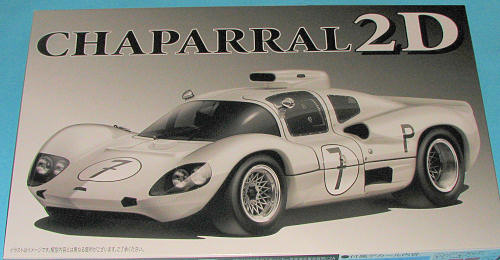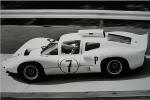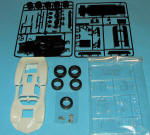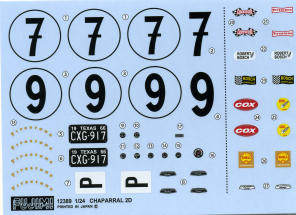
Fujimi 1/24 Chaparral 2D
| KIT #: | 12389 |
| PRICE: | 3600 yen (about $43 from Hobby Link Japan) |
| DECALS: | Two options |
| REVIEWER: | Scott Van Aken |
| NOTES: | Reissue |

| HISTORY |
Chaparral Cars was a United States automobile racing team which built prototype race cars from the 1960s through the early 1970s. Chaparral was founded in 1962 by Hap Sharp and Jim Hall, a Texas oil magnate with an impressive combination of skills in engineering and race car driving. The name "Chaparral" was formed from the last names of the two founders. Throughout the 1960s and 1970s, Chaparral's distinctive race cars experienced strong success in both American and European racing circuits. Despite winning the Indy 500 in 1980, the Chaparrals left motor racing in 1982. Chaparral cars also featured in the SCCA/CASC CanAm series and in the European FIA Group 7.
Chaparral was the first to introduce effectively designed air dams and spoilers ranging from the tabs attached to the earliest 2 model to the driver-controlled high wing 'flipper' on the astoundingly different looking 2E, all the way through to Hall's most idealistically inspired creation, the 2J, the car that would forever be known as the 'vacuum cleaner', and was the forerunner of modern "ground-effects" cars. The use by Jim Hall of a semi-automatic transmission in the Chaparral created flexibility in the use of adjustable aerodynamic devices.
The development of the Chaparral chronicles the key changes in race cars in the '60s and '70s in both aerodynamics and tires. Jim Hall's training as an engineer taught him to approach problems in a methodical manner and his access to the engineering team at Chevrolet as well as at Firestone changed aerodynamics and race car handling from an art to empirical science. The embryonic data acquisition systems created by the GM R&D group aided these efforts.
The Chaparral 2-Series was designed and built to compete in the United States Road Racing Championship and other sports car races of the time, particularly the West Coast Series that were held each fall. Following the lead of innovators like Bill Sadler from Canada and Colin Chapman who introduced rear engined cars to Grand Prix cars in Europe (where Jim Hall had raced in Formula 1), its basic design concept was a rear engined car.
First raced in 1963, it was developed into the dominant car in the series in 1964 and 1965. Designed for the 200 mile races of the sports car series, it was almost impossible to beat. It proved that in 1965 by winning the 12 Hours of Sebring on one of the roughest tracks in North America.
As the car was being developed, Jim Hall took the opportunity to implement his theories on aerodynamic force and rear wheel weight bias.
In addition, the Chaparral 2-Series featured the innovative use of fiberglass as a structural element. Hall also developed 2-Series cars with conventional aluminum chassis.
It is very difficult to identify all iterations of the car as new ideas were being tested continually. There are three generally accepted variants:
Coincidental with the development of aerodynamics was Hall's development of race tires. (This is a complex subject that should have a separate article.) Jim Hall owned Rattlesnake Raceway adjacent to his race shop; that proximity allowed him to participate in much of Firestone's race tire development.
A two-article series in "Car and Driver" magazine featured Jim Hall's design theories. The article turns speculation about vehicle handling into applied physics. It was the precursor to the elaborate data collection and management of current racing teams. Hall's methodology was probably the first documented approach to measuring and managing the properties of race cars.
 2D
2DThe 2D, and subject of this kit, was a closed cockpit variant of the 2A/B/C series (which were all open cockpit designs), designed for endurance racing in 1966. It won at 1000 km Nürburgring in 1966 with Phil Hill and Joakim Bonnier driving (shown in photo with Bonnier at the wheel). It competed in the 1966 24 Hours of Le Mans, withdrawing after 111 laps. The car was also raced during the 1967 season at select events, but rarely did well.
| THE KIT |
 Despite
the 2010 date on the side of the box, I'm thinking this may, and I say may, well
be a reissue. I'm not that conversant on car kits.
Despite
the 2010 date on the side of the box, I'm thinking this may, and I say may, well
be a reissue. I'm not that conversant on car kits.
The kit is molded in black plastic with a white body and the usual clear sprue. This is very much a curbside with the interior consisting of a plastic section that includes a molded on engine shape. It does look like a small block Chevy with Weber downdraft carbs; there just isn't a ton of engine detail. Having the lower body /chassis and roof intake in black will require some primer prior to painting it white. Same may be true for the wheels, though if one uses a nice metallic shade, like Alclad, the black will be a good basis for some of the more shiny shades.
 In
addition, there are a number of metal parts for the head lights, tail lights,
rear view mirrors and fuel caps. They are not as shiny as shown on the box art.
The kit also includes five rubber tires (the racing rules required a spare).
There are optional parts for two cars. One as raced at Nurburgring and the other
at Le Mans in 1966. There are differences in the rear spoiler and various scoops
and lights that one should take into consideration during the build.
In
addition, there are a number of metal parts for the head lights, tail lights,
rear view mirrors and fuel caps. They are not as shiny as shown on the box art.
The kit also includes five rubber tires (the racing rules required a spare).
There are optional parts for two cars. One as raced at Nurburgring and the other
at Le Mans in 1966. There are differences in the rear spoiler and various scoops
and lights that one should take into consideration during the build.
Instructions are quite well done with very nicely drawn construction steps. These include all painting information and there is a Gunze paint reference. Decals are nicely printed and have tire lettering decals in addition to race number and race sponsor markings. The only color for any Chaparral sports racer or GT is white.
| CONCLUSIONS |
I'm a Chaparral fan and have been for most of my life. When a kit of one of these cars comes available, I'm always looking for it. Thanks to Fujimi and Hobby Link Japan, you can now get a very nice curbside of this famous and sharp looking car.
| REFERENCES |
http://en.wikipedia.org/wiki/Chaparral_2D#2D
Thanks to Hobby Link Japan for the preview kit. Get yours at the link.
If you would like your product reviewed fairly and quickly, please contact me or see other details in the Note to Contributors.